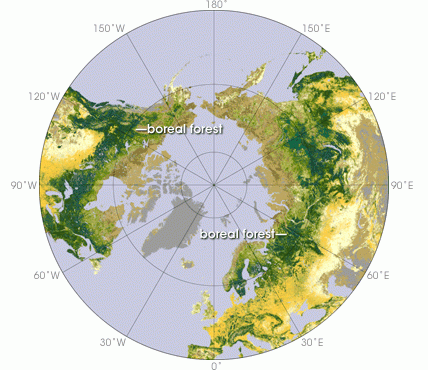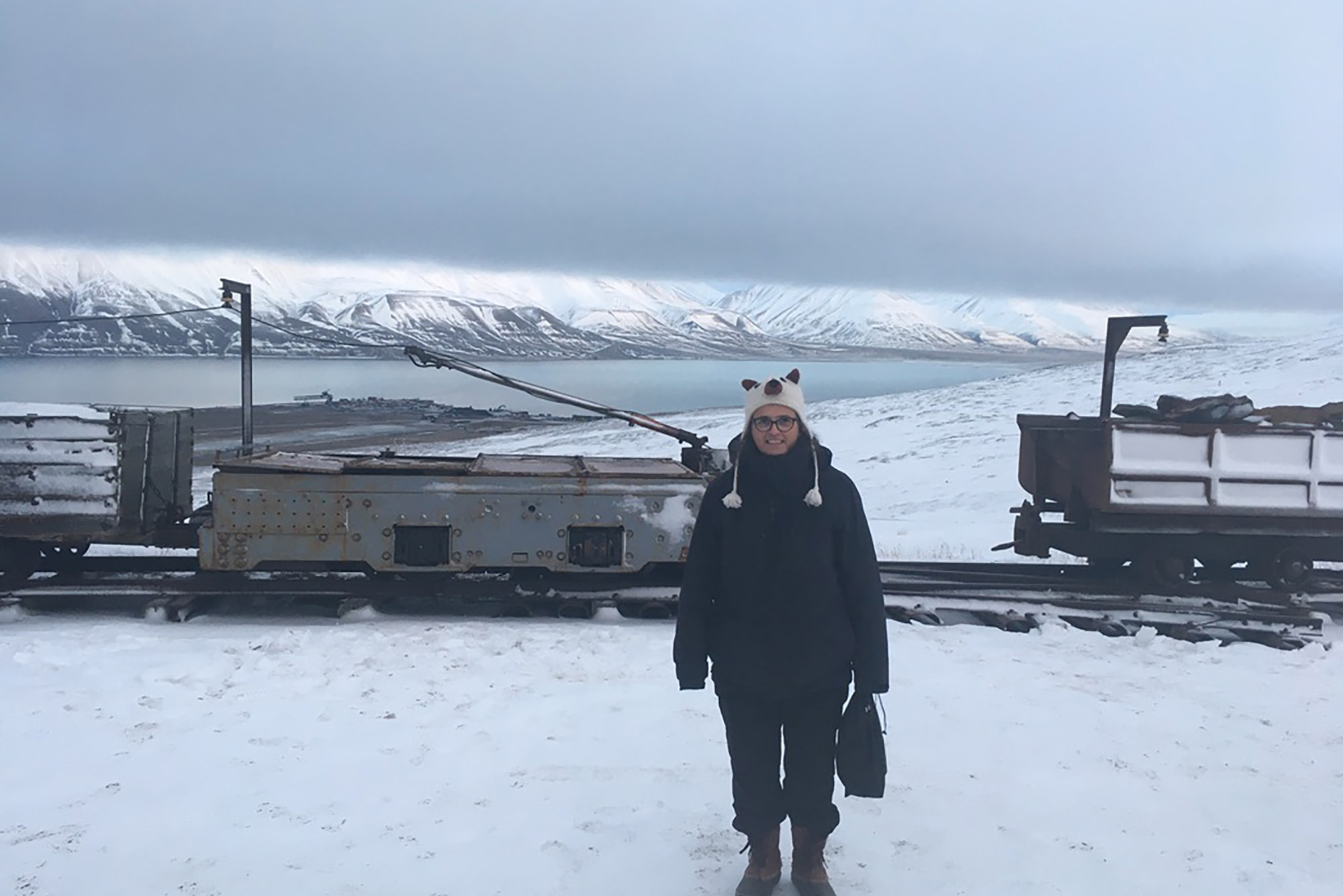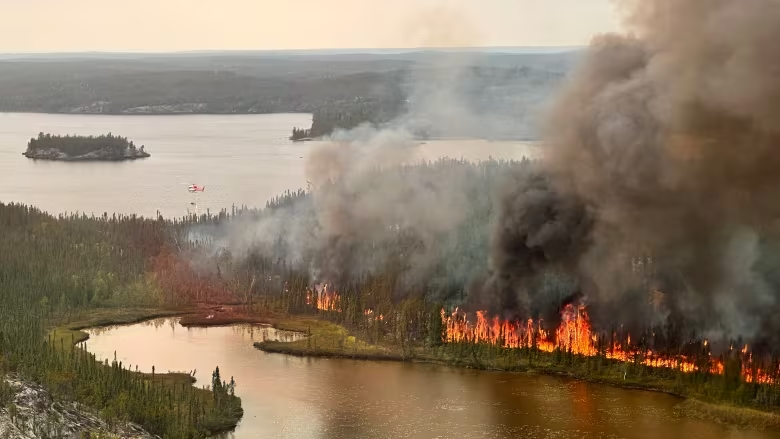The Arctic is rapidly warming, and wildland fires are sweeping across the region with devastating consequences.
“Arctic wildland fire has gone from being an effect of global climate change to a driver of it,” says Edward Alexander, co-chair of the Gwich’in Council International – a non-profit organization that represents 9,000 Gwich’in people in Alaska, the United States, and the Yukon and Northwest Territories in Canada.
Alexander resides in Fairbanks, just south of the Arctic Circle in Alaska, where wildfires affect both human and animal inhabitants.
“I say I come from the future,” Alexander says.
In other words, a place where 65 percent of the land has burned. And it is heading south.
The boreal forest in danger
Alexander highlighted the devastating consequences of Arctic wildfires during a panel discussion at the Arctic Encounter Symposium in Anchorage, Alaska, this week. Particularly, he noted the impact on the boreal forest.
What is the Boreal Forest?
The boreal forest grows within the boreal zone that circles the world just south of the Arctic Circle. Countries with forests and land in the boreal zone include Canada, the United States, Norway, Sweden, Russia, China, and a few others. Worldwide, the boreal zone covers 1.9 billion hectares.
Boreal forests are full of life that is adapted to withstand frigid temperatures year-round, such as caribou reindeer, or animals that can migrate long distances every winter.
Forest fires have always occurred In the boreal zone and have helped the forest renew itself. The spruce-dominated boreal forests are adapted to high-intensity fires that only used to return years apart.
As climate change speeds up the return of fires with hotter and drier conditions, boreal forests have begun to suffer major losses.
“Fire will occur if the circumstances are right,” Edward Alexander explains.
Will not stay in the Arctic
But now climate change has pushed the balance past the breaking point. Global warming has set the Arctic on fire with increased summer temperatures and lower winter temperatures.
“This will transfer to the rest of the Arctic,” Alexander warns.
And when he says that 65 percent of the land has burned, it is not just wasteland.
Must start now
“Do not forget that there are actual homelands burning. I am talking about communities, about traplines. I am talking about impacts on actual people’s ways of life, and that is something that we are going to have to deal with collectively,” Alexander says.
And it must start now. Or yesterday, as Alexander puts it.
“What happened in the Yukon flats is going to continue to happen around the circumpolar and so we need to work together”.
Yukon Flats Wildfires:
The Yukon Flats is one of the most fire-prone regions of Alaska and is subject to repetitive but irregular, long-term cycles of burning and regeneration.
Wildfire activity is increasing on the Yukon Flats as it is across much of Alaska. More acres burn each year, the frequency of fires is increasing, and more fires smolder underground, surviving winter and reigniting the next spring. Since 1988, the frequency of years that burned over 250,000 acres on the Yukon Flats quadrupled.
The Wildland Fire Initiative
To combat the out-of-control wildfires, the Arctic Council under the Norwegian chairship, launched the “Wildland Fire Initiative” last October, which seeks to elevate this urgent climate change issue on the Arctic agenda.
The Arctic Council states that wildland fires are now a critical environmental concern with far-reaching ecological, social, economic, and cultural implications serving as a stark reminder on the urgency of addressing climate change and its immediate and long-term impacts in the Arctic and globally.
Climate change causes and accelerates Arctic wildfires in several ways. As temperature rise, the number of lightning strikes increase, the snow cover is reduced, and land surfaces become drier.
As a result, the Arctic is seeing more and larger fires that are more intense and stretched over a prolonged fire season.
Research suggests that the combined impact of human activity and natural forces on the climate have made extreme fire risks up to six times more likely in some areas.
We must urgently address climate change to minimize its immediate and long-term impact in the Arctic and globally – Morten Høglund, Senior Arctic Official Chair of the Arctic Council
A threat
This causes accelerated warming as black carbon and other emissions are released into the atmosphere. Current estimates indicate that, for example, 12 to 15% of the total deposition of black carbon in the Arctic originates from boreal forest fires in Siberia, Canada, and Alaska.
The fire threatens life and property, alters available local food sources, and degrades air quality for people living in the Arctic, resulting in significant economic loss from property damage as well as physical and mental health impacts.
Over the past years, the Arctic Council has been working extensively on wildland fires, monitoring and addressing wildfires on multiple levels, including fire types of prevention and response strategies, safety measures, cross-border cooperation about climate and health impacts, and the utilization of indigenous knowledge and local knowledge.
A stark reminder
Ambassador Morten Høglund, Senior Arctic Official Chair of the Arctic Council, says that fires we have seen in recent years will increase in frequency and severity.
“This serves as a stark reminder that we must urgently address climate change to minimize its immediate and long-term impact in the Arctic and globally. To do this, we need to turn our attention towards better understanding the causes and impacts of wildlife fires on the Arctic ecosystems and communities,” Høglund says.
As mentioned above, frequent wildfires also have a negative impact on people’s mental health.
Savannah Fletcher, Presiding Officer of the Fairbanks North Star Borough Assembly, explains the feeling of being trapped inside your house after a long, dark winter.
“In the winter, it is cold and dark, and then summer comes to give us a break. But then it is not safe to go outside and breathe the air,” Fletcher says.
“And because houses in the Arctic are isolated to keep warm, it is necessary to open the windows during warm summer days. But that is not an option, so you are stuck between the overheated house or opening the window while breathing in polluted air,” Fletcher says.
Together
Morten Høglund states that it is important for the Arctic States and the rest of the world to find solutions together.
Circumpolar issues require circumpolar cooperation. – Morten Høglund, Senior Arctic Official Chair of the Arctic Council
“The issue of wildfires has been part of the council’s agenda for years, and the council’s working groups have their own projects and initiatives aimed at addressing fire ecology and fire emergency response.”
The Arctic Council’s wildfire initiative aims to increase collaboration, knowledge sharing, and partnership to tackle the problem.
More accessible
“We aim to pull together collective expertise, experiences, and resources on wildfires and identify knowledge gaps. We seek to engage experts and knowledge holders from the Arctic Council and partners and partner with wildfire activities and projects led by external partners,” Høglund says.
In doing so, the council wants to make information and archives more accessible through public panels, campaigns, and other communicative efforts that will span across the Arctic.
“Circumpolar issues require circumpolar corporation. We need to learn from people across the Arctic and beyond, who experience the fires firsthand, who might provide us with the knowledge and insights needed to find common solutions”, Høglund finishes.
The Wildland fire circle
The Arctic is warming more than three times the rate of the rest of the world, which allows industry and agriculture to move further north.
Most wildland fires are sparked by human activity, even in the Arctic. A warming Arctic has more lightning strikes, further increasing the likelihood of fires.
Once a fire starts, climate change can create conditions for especially intense fires on dry peatlands and forests.
Arctic fires feed further warming. Burning peat creates big, smoky fires that release greenhouse gases, which trap even more heat.
Black carbon from soot settles on snow and ice, absorbing the sun’s heat. This increases the rate of melting, creating a warmer Arctic and even greater fire risk.
Source: The Arctic Council
Fire suppression
Last year, that is what happened in the Yukon Flats, where millions of acres will be protected from wildfire through fire suppression in the Yukon Flats National Wildlife Refuge within 72 hours of detection to protect the ancient permafrost and stop carbon from being released into the atmosphere.
During the debate, Torre Jorgenson, an Affiliate Professor at the University of Alaska Fairbanks, explained that the Yukon Flats contain 1.6 million acres of deep ice-rich permafrost, which is estimated to hold 1.1 gigatons of carbon.
Jimmy Fox, Yukon Flats National Wildlife Refuge Manager at U.S. Fish & Wildlife Service, says it is important to remember that the Arctic burns differently than the rest of the world.
“Wildland fires in the lower 48 U.S. states have historically been low intensity yet high frequency, just the opposite of fires in the northern region”, says Fox.
He says forest wildfire in the Yukon flats has quadrupled since 1988.
“We also hope to reduce air pollution and its impacts to hundreds of local residents and even people living farther away.”

Use indigenous knowledge
Burning the land has been a tradition among the indigenous people of the Arctic for thousands of years. That is why Edward Alexander feels strongly about using indigenous knowledge to combat and understand the out-of-control wildfires.
He explains this in a comment on the project website:
“Gwich’in burn grass during early springtime in the North, when the meadows have thawed, but there is still snow around the timberline.”
This was traditionally important because it increased the biodiversity of plant species growing in that area, fertilized the soil so that plants were more nutritious, and increased the land’s animal-carrying capacity.
“There would be an increase in rabbits, and moose would have two or three calves instead of just one. It is also a carbon-neutral practice to burn the land during that specific time due to the low amount of carbohydrates in the soil”, Alexander explained.
So, it is important to understand that if that same fire was lit just a month later, it could be extraordinarily destructive, destroying the rich structures of those plants, interfering with migrating animals, and more.
“It is important to gather information like this to understand how people have worked with fire in the past to better manage what we have going forward.”
Alexander points out that it is not enough to talk about management regimes without talking about Indigenous management and techniques that have been successful in the North for thousands of years.
“These practices and Indigenous knowledge do not need to be historical. If we can find and understand more examples of Indigenous knowledge about wildfire, I am absolutely certain it will be useful to all of us in a circumpolar and global context as fires become not only an effect of climate change but a global driver of it.”





I do believe all the ideas you’ve presented for your post. They are really convincing and will certainly work. Thanks for the post!